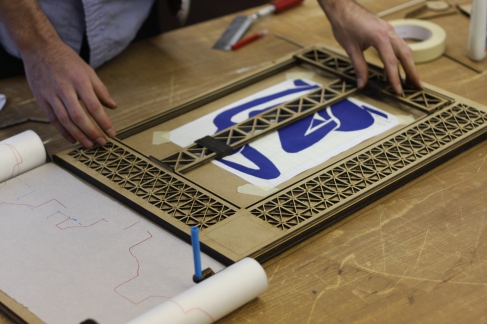Our initial research focused on several drawing machines from the Renaissance such as Jacopo Barozzi da Vignola’s Bi-Dimensional perspectograph (developed between 1527-1545), Jacques Besson’s Drawing Machine from Theatrum instrumentorum et machinarum (1578), Albrecht Dürer’s perspectograph (Dürer’s Door – 1525) and other machines that have since been reiterated by people such as JH Lambert in 1752 and recently for purposes of abstract art by Eske Rex.
Inspired in most part by a machine developed by an unknown artist we saw on the internet, we became interested in developing a drawing machine that would generate the cams that could produce a 2-D drawing.
A cam changes the input motion, which is usually rotary, to a reciprocating motion of the follower. Cams can be shaped to change the way the follower moves. The shape of the cam is called the profile. If a cam rotates clockwise, the movement of the follower in 1 would be a gradual rise and fall motion for each rotation; the follower in 2 would rise and fall twice for each rotation; in 3, the follower would be motionless for half the cycle and then rise and fall; and the follower in 4 would rise gradually and then fall suddenly. Note that 1, 2 and 3 would have the same result if the cam was rotating anticlockwise; 3 would jam. These aren’t the only shapes you can use. Anything goes…depending on what sort of motion you want…though there are practical limitations to making these things out of wood.
Our drawing machine, thus, acts to develop a shape (not necessarily circular) that would deconstruct a drawing into horizontal and vertical data. Theoretically, this data could in turn be plugged back into the process to generate the original drawing.
Next we decided to fabricate a machine that would automate step two. For this to occur, a series of gears would navigate two arms vertically and horizontally. These arms are connected to the “master” pen that traces a 2-dimensional drawing. The veritcal and horixzontal arms hold pens to record data on a moving canvas. We decided to deconstruct Henri Matisse’s “Blue Nude” (1952). Matisse’s painting is a rather simple outline of 2-Dimensional figure, one that would be fairly easy to trace with our machine. Furthermore, we were intrigued to see the outcome that would occur by deconstructing an already semi-abstract painting.

